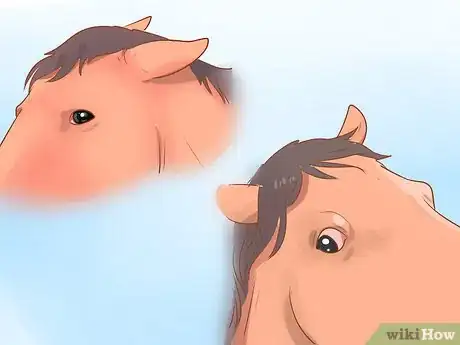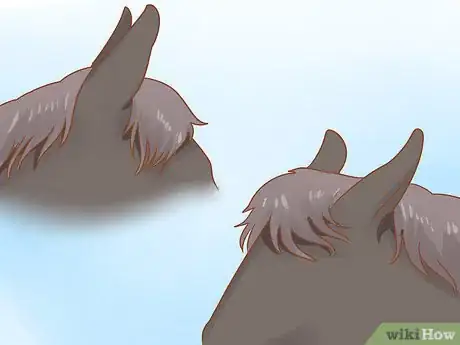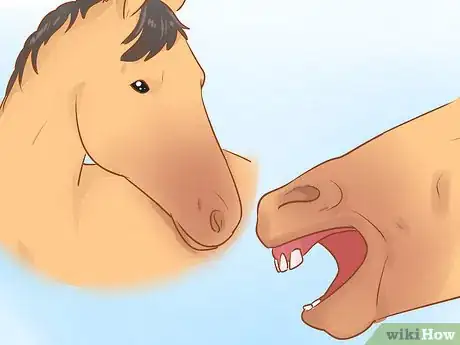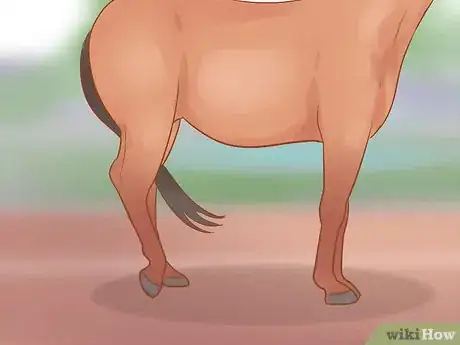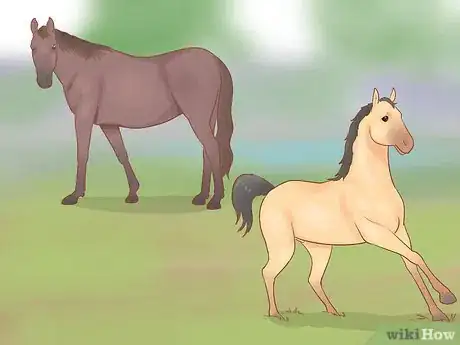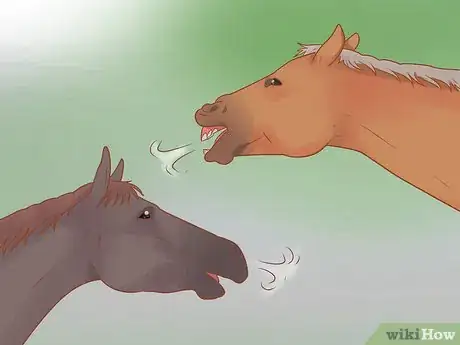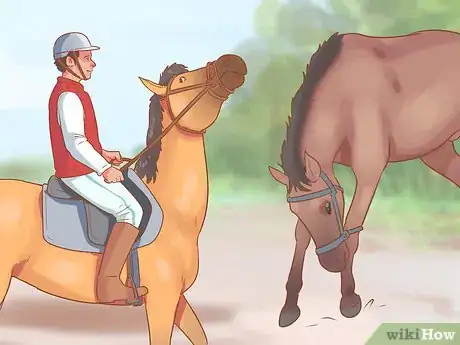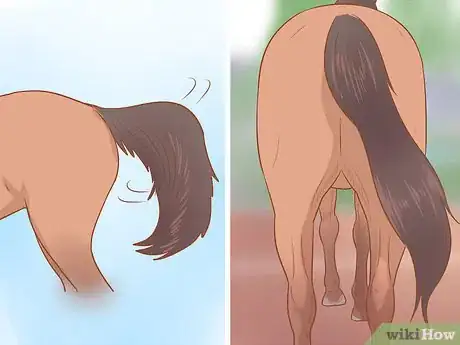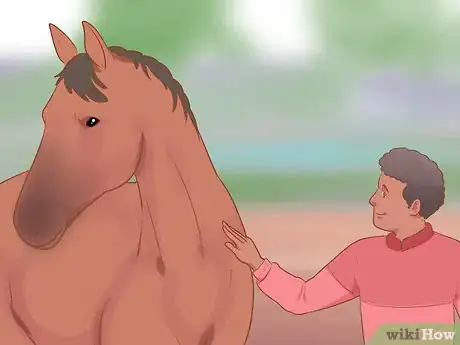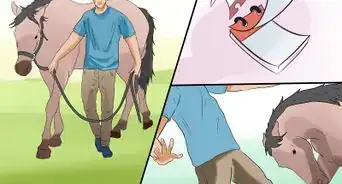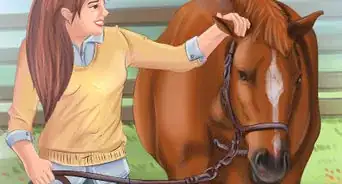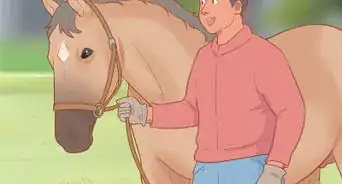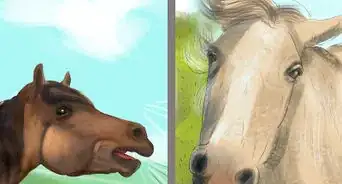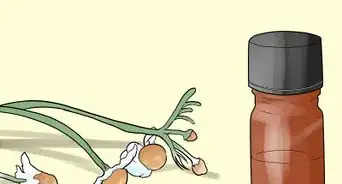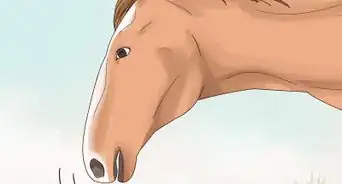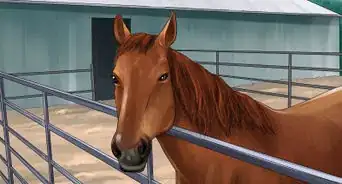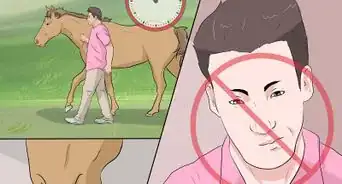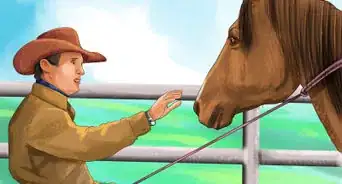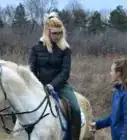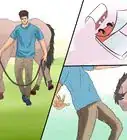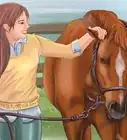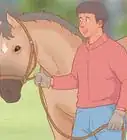This article was co-authored by Pippa Elliott, MRCVS. Dr. Elliott, BVMS, MRCVS is a veterinarian with over 30 years of experience in veterinary surgery and companion animal practice. She graduated from the University of Glasgow in 1987 with a degree in veterinary medicine and surgery. She has worked at the same animal clinic in her hometown for over 20 years.
wikiHow marks an article as reader-approved once it receives enough positive feedback. This article received 14 testimonials and 95% of readers who voted found it helpful, earning it our reader-approved status.
This article has been viewed 446,489 times.
Have you ever wondered what a horse is trying to say to you, or maybe to another horse? Horses use their body language and vocalizations to communicate with each other and to the people around them. All good horse training requires a thorough understanding of horse behavior and language to achieve successful and caring outcomes. Understanding your horse’s behavior and language will help you relate to your horse in a much more meaningful way and will deepen the bond between you and your horse.
Steps
Understanding Your Horse’s Eyes, Ears, and Facial Expressions
-
1Look at your horse’s eyes. Paying attention to your horse’s eyes will help you understand how your horse is feeling (eg, alert, sleepy) at any given moment. Keep in mind that a horse’s vision is different from that of a person. For example, horses have a panoramic view of their environment (like a panoramic camera); because they are prey animals in the wild, it is important for them to have a wide view of their surrounding environment. Horses can also have poor depth perception, meaning that they cannot always perceive how deep or shallow something is; what we see as a shallow puddle may look like a bottomless pit to your horse.
- If your horse’s eyes are bright and wide open, this means that your horse is alert and aware of his surroundings.[1]
- Eyes that are open only halfway indicate a sleepy horse.[2]
- If both of your horse’s eyes are shut, your horse is sleeping.
- If only one eye is open, it is possible that something is wrong with the other eye. You may need to call your veterinarian to determine why the other eye is closed.[3]
- Sometimes your horse will move his head in different directions to get a better of view of his surroundings.
-
2Observe how your horse’s ears are positioned. Horses will hold their ears in different ways to pick up different signals from their environment and indicate how they feel about what’s going on around them. Horses can move both their ears at one time, or move them individually.
- Ears that are slightly forward indicate that a horse is relaxed. If your horse’s ears are pricked forward, he may be feeling interested in, or maybe even threatened by, his environment. If his ears indicate that he is feeling threatened, his nostrils will flare and his eyes will widen.
- Ears that are flattened back are a clear sign that your horse is upset.[4] If you are near your horse when you see this, move a safe distance away to protect yourself from injury.
- If one ear is back, then your horse is likely listening to something behind him.[5]
- If your horse’s ears are to the side, that means that he is concentrating yet relaxed. [6]
Advertisement -
3Watch your horse’s facial expressions. Horses can make a variety of facial expressions in response to their environment. Often, changes in a horse’s facial expression accompany other changes in body language.
- Your horse’s chin and/or mouth will droop when he’s feeling relaxed or sleepy.[7]
- A curl of the upper lip indicates the flehmen response. Although this looks funny to people, the flehmen response is a useful way for horses to interpret unfamiliar scents in their environment. In order to display the flehmen response, your horse will extend his neck, raise his head, inhale, and roll his upper lip back and under itself; your horse's upper teeth and gums will be exposed when he does this.[8]
- Foals, weanlings (recently weaned from their mother), and submissive yearlings will clack their teeth to make sure that older horses don’t hurt them. They’ll do this by first raising their neck and pushing out their head. They will then curl their upper and lower lips to expose all of their teeth, and repeatedly click their teeth together. You will hear a small clicking noise if your horse does this.
Understanding Your Horse’s Legs, Posture, and Voice
-
1Observe what your horse is doing with his legs. Horses will use their back and front legs in different ways to indicate how they are feeling. Horses can inflict serious injury with their legs, so understanding how your horse uses his legs to communicate will be very important for your personal safety.
- Your horse will paw or stamp the ground with his front legs when he is feeling impatient, frustrated, or uncomfortable.[9]
- Splayed (spread out) front legs indicates that your horse is getting ready to run or bolt. It could also mean that your horse has medical issues that prevents him from standing properly; your veterinarian will be needed to diagnose the underlying cause.
- Lifting either one front leg or back leg signals a threat. If you see your horse doing this, step back to a safe distance; a horse kick can cause serious injury.
- Your horse may cock his back leg by resting the front edge of his hoof on the ground and lowering his hip. This indicates that he is relaxed.
- Your horse will sometimes engage in Bucking behavior, which is when he raises his back legs in the air. This is often playful behavior (sometimes accompanied by grunting and squealing), but can also indicate uncertainty and fear, especially if he's being ridden for the first time.
- Rearing up is another dual-sided behavior. It can signal playfulness in foals in the field but, if it is an angry stallion in fight mode, it can be a sign of fear when the horse cannot escape the situation.
-
2Look at your horse’s overall posture. You can understand how your horse is feeling by looking at him as a whole to see how he moves and stands. For example, if your horse’s back is raised, he could be sore from having the saddle on him for a long time.[10]
- Rigid muscles and stiff movements can mean that your horse is nervous, stressed, or in pain. If you are not sure why your horse looks rigid or stiff, your veterinarian can conduct various behavioral and medical tests (dental exam, lameness exam) to determine the cause.
- Trembling is a sign of fear. Your horse may tremble to the point of wanting to run or fight. If he does this, give him plenty of space and time to calm down. He may also need to be desensitized to his fear; an experienced veterinary behaviorist can help your horse overcome his fear.
- Your horse may swing his hindquarters to indicate that he’s getting ready to kick; move away quickly if he starts doing this. If your horse is female, she may swing her hindquarters to indicate that she is in heat and trying to get the attention of a male horse.
-
3Listen to what noises your horse makes. Horses have a range of noises that they will make to communicate different things. Understanding what these different noises mean will help you better understand what your horse is trying to communicate with you and other horses.
- Your horse will neigh for several reasons. He may neigh to indicate anxiety or distress; this will be a very high-pitched sound and could be accompanied by a lowered tail and flickering ears. He may also neigh to acknowledge his presence. A confident neigh will sound like a bugle and will be accompanied by a slightly lifted tail, forward-pricked ears.
- A nicker is a soft, throaty sound. To make this sound, your horse will keep his mouth closed while producing the sound from his vocal chords. A mare will sometime use this sound with her foal. Your horse may also make this sound when he knows that it’s almost feeding time. This is usually a friendly sound.
- Squeals can be a display of threat. Two horses who are meeting each other for the first time may squeal at each other. Squeals can also be a sign of playfulness, such as when your horse is bucking.
- Your horse will snort by inhaling quickly and then exhaling through his nose. With this sound, he could be signaling that he is alarmed when another animal has come too close to him. He could also be indicating that he's excited about something. Be aware that the act of snorting can get horses worked up; you may need to calm him down if this happens.
- Just like people, your horse will sigh to express relief and relaxation. The sighs are different for each each emotion: relief–deep inhale, then a slow exhale through the nose or mouth; relaxation–lowered head with an exhalation that makes a fluttering noise.
- Groans can indicate different things. For example, your horse may groan if he's in pain during riding (eg, landing hard after a jumping a fence, his rider thuds heavily in the saddle). He might also groan when he's happily exercising without pain. Groaning could also indicate more serious medical issues, such as constipation or gastric pain due to ulcers. If you have trouble determine why your horse is groaning, consult a horse expert.
Understanding Your Horse’s Head, Neck, and Tail
-
1Watch how your horse has his head positioned. As with other parts of the horse’s body, your horse will move his head in different ways depending on how he’s feeling. The position of his head signals a variety of moods.
- If your horse is holding his head high, he is showing that he is alert and curious.[11]
- A lowered head could mean several different things. It could mean that your horse has accepted a particular situation or command.[12] It could also mean that your horse is depressed, which could require additional workup from your veterinarian.[13]
- If your horse is snaking his head (lowering his head slightly and moving his neck from side to side), he is showing signs of aggression. If possible, remove your horse from whatever is aggravating him. If you cannot do this safely, move as far back from your horse as you can until he calms down. If he is walking or running while doing this, he is a leader trying to move his herd. Know that when he does this to people, he sees them as lower and himself as a leader.
- Your horse may turn his head to look back at its flank, which could signal abdominal discomfort or just an itch. This is not a cause for concern unless it is repeated and seems to be accompanied by biting.[14]
-
2Observe how your horse moves his tail. Your horse will swish his tail for reasons than swatting away flies or insects. Although natural tail position can vary by breed, there are some tail positions that are common across breeds.
- In addition to swatting away bothersome pests, tail swishing can also indicate agitation and can be a warning for other horses to keep their distance. If your horse is agitated, he will swish his tail more quickly and aggressively than if he was swatting away pests. Doing this while walking away from a horse that has moved in means they have surrendered to a leader, but are not happy about it.
- Your horse will often raise his tail when he is feeling happy and alert.[15] In foals, a tail held high over the back can indicate either playfulness or alarm.
- If your horse’s tail is clamped down, your horse may be experiencing some discomfort, such as a fly on his underside or may be uncomfortable with your actions.[16]
-
3Observe how your horse's neck looks and feels. Your horse will hold his neck in different ways to convey whether he's feeling tense, relaxed, etc. Knowing these different neck positions will help you better understand your horse's body language.
- If your horse's neck is stretched out and the muscles under his neck feel loose, this can indicate that he is relaxed and happy.
- If the muscles under your horse's neck feel tense, your horse probably feel stressed and unhappy.
Warnings
- An angry, nervous, or fearful horse can be dangerous and cause serious physical injury. Always put your safety first.⧼thumbs_response⧽
- The most dangerous horses are often those that were babied as foals. They do not know they are stronger than humans and are used to laying on top of, jumping up on, and pushing people. These horses do not understand because the behavior was reinforced throughout childhood and they know they are not trying to hurt anyone. Some male horses like this will even try to mount an unsuspecting person. Please exercise extreme caution when interacting with horses of this background.⧼thumbs_response⧽
- A horse that always bucks and rears is a reflection of his training. It is advisable to stick with groundwork until he has mastered that, then slowly reintroduce riding.⧼thumbs_response⧽
- A helmet may prevent some injuries, but cannot protect from everything. In fact, they often inspire an overconfident recklessness which can cause people to engage in behavior they might never dream of under normal circumstances. It is fine, even encouraged to wear a helmet, but riders must be careful to remain realistic about their and their horses' ability level.⧼thumbs_response⧽
- Remember that training is a process, not an event; in many ways more like learning to speak than learning to add. One can say they will learn to add on this day, but no one can say they will learn to speak on this day. People just progress until they realize suddenly that they are speaking. When did you become fluent in your first language? It is hard to say. But I am sure a school could give certain dates upon which you learned to add. Teach your horse skills like people teach babies to talk.⧼thumbs_response⧽
References
- ↑ http://www.equestrianandhorse.com/equus/behaviour.html
- ↑ http://www.equestrianandhorse.com/equus/behaviour.html
- ↑ http://www.equestrianandhorse.com/equus/behaviour.html
- ↑ http://www.angelfire.com/tx2/kidshorses/bodylang.html
- ↑ http://www.equestrianandhorse.com/equus/behaviour.html
- ↑ http://www.equestrianandhorse.com/equus/behaviour.html
- ↑ http://www.equestrianandhorse.com/equus/behaviour.html
- ↑ http://www.proequinegrooms.com/index.php/tips/health-and-well-being/the-flehmen-response-in-horses-what-does-it-mean/
- ↑ http://www.equestrianandhorse.com/equus/behaviour.html
- ↑ http://www.equestrianandhorse.com/equus/behaviour.html
- ↑ http://www.equestrianandhorse.com/equus/behaviour.html
- ↑ http://livestocktrail.illinois.edu/horsenet/paperDisplay.cfm?ContentID=1253
- ↑ http://www.equestrianandhorse.com/equus/behaviour.html
- ↑ http://www.equestrianandhorse.com/equus/behaviour.html
- ↑ http://www.equestrianandhorse.com/equus/behaviour.html
- ↑ http://www.equestrianandhorse.com/equus/behaviour.html
- ↑ http://livestocktrail.illinois.edu/horsenet/paperDisplay.cfm?ContentID=1253
About This Article
To understand horse communication, start by paying attention to your horse’s ears, which will be slightly forward or to the side if your horse is relaxed. Alternatively, if its ears are pricked forward or flattened back, your horse may be upset. Additionally, listen to your horse and assume it’s happy when it nickers, or relived when it sighs. However, if you hear squealing or high-pitched neighing, your horse may be feeling threatened or in distress. You should also check your horse’s tail to make sure it’s not clamped down, because that can signal discomfort. For more tips from our Veterinary co-author, like how to interpret your horse’s head and neck movements, read on!
